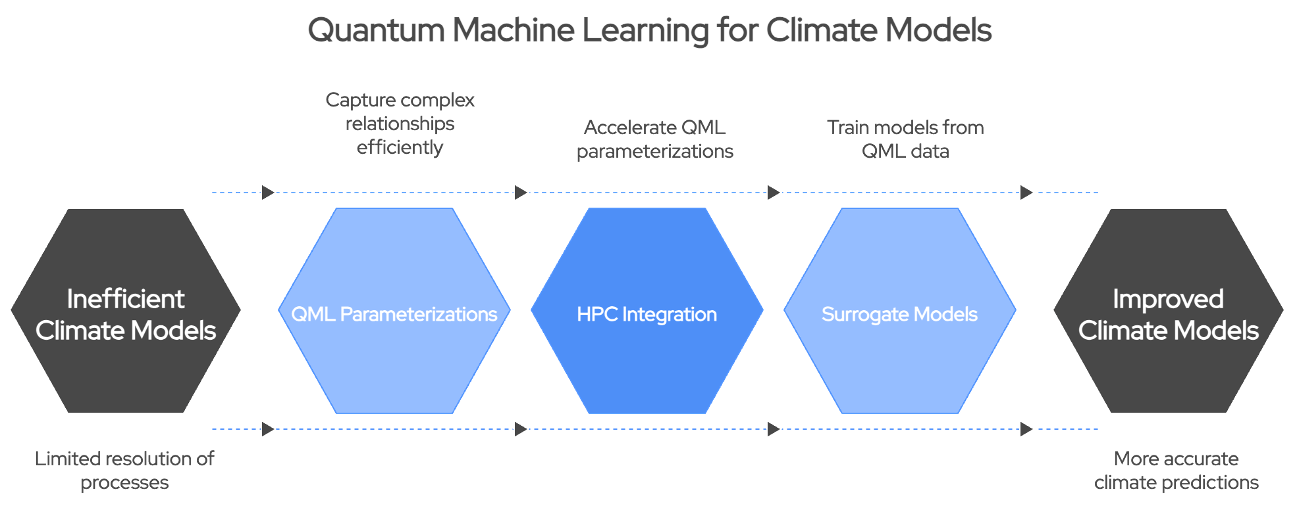Climate change is accelerating, and our ability to adapt depends on how well we can project its future impacts. Climate models are the most important tools we have for this, yet even the most advanced models struggle with uncertainty, especially when it comes to regional detail. A new position paper by climate scientists and quantum computing experts explores how quantum computing could help address these challenges and accelerate progress in climate modeling.

Climate models simulate the Earth system by solving physical equations for the atmosphere, ocean, land, and ice. They divide the globe into a grid and calculate how properties like temperature, winds, and moisture evolve.
Higher resolution models are more accurate because they resolve small-scale processes such as cloud formation or convection. But they come with heavy costs:
Machine learning has already been integrated into hybrid climate models to represent these unresolved processes. While promising, challenges remain. Models may become unstable, or they may fail to generalize under shifting climate conditions. More expressive and efficient methods are needed.
Quantum computing introduces a fundamentally different way of processing information. Although current devices are still limited and many rigorous linear-algebra-based speed-ups require fault-tolerant quantum computing (FTQC), research points to several areas where they could bring value to climate modeling.
Key opportunities include:
At the heart of every climate model are differential equations that describe conservation of mass, energy, and momentum. Solving them becomes extremely costly as resolution increases.
Quantum linear algebra solvers and quantum lattice–Boltzmann methods have been proposed as potential accelerators. They could, in theory, achieve exponential speed-ups over classical methods. Early work has shown promise for fluid flow equations, but the challenge lies in efficiently encoding climate variables into quantum states and retrieving meaningful outputs. In practice, read-out is a bottleneck: only a few variables can be extracted per run, so workflows trend toward many repeated runs rather than large single outputs, and benefit from tight HPC–QC integration to manage latency.
Even modest progress here would be impactful, as computational fluid dynamics is one of the main bottlenecks in climate modeling.

Parameterizations approximate processes that cannot be directly resolved in climate models. Examples include turbulence and cloud physics.
Quantum neural networks and other QML models could be used to develop parameterizations with greater expressivity. This means they could capture complex relationships with fewer parameters and potentially less training data.
Early demonstrations already show that some quantum models can outperform classical ones on subsets of climate-relevant datasets, predicting variables such as precipitation rates and solar fluxes. A QML-based parameterization of cloud cover has also been tested in a climate model, showing that integration is possible.
The current limitation is runtime. Running QML parameterizations at every grid cell and time step would take too long with today’s devices. Future integration with high-performance computing and the use of surrogate models trained from QML could help bridge this gap.
Climate models have many adjustable parameters. Finding the right values, known as tuning, is essential for accuracy but requires expert knowledge and large amounts of computing.
Quantum computing could help by:
Automatic tuning methods are already being tested in climate modeling, and quantum approaches could add new flexibility and speed.
Model evaluation is about identifying biases and improving robustness. This requires understanding the probability distributions underlying model outputs.
Quantum generative models can efficiently represent complex distributions, potentially with fewer parameters than classical methods. Once trained, they could generate new samples of climate data for further analysis.
Quantum classifiers may also improve how climate data is categorized, helping refine comparisons with observational datasets. Both approaches could strengthen evaluation pipelines, leading to better confidence in climate projections.
While the opportunities are significant, practical use of quantum computing in climate modeling faces several hurdles:
Despite these challenges, the paper highlights clear next steps. Early work can focus on simplified models and test cases, such as shallow water equations or small parameterization problems. Surrogate approaches can be explored to benefit from QML during training while relying on classical models during simulation.
Collaboration is key. Climate scientists, quantum researchers, and computer scientists will need to co-design solutions, tailoring algorithms and hardware to real climate applications.
Quantum computing will not replace existing climate models, but it has the potential to accelerate and enhance them in specific areas. By addressing computational bottlenecks, improving parameterizations, and supporting tuning and evaluation, it could contribute to more accurate and reliable climate projections.
Starting this exploration now is important. With continued progress in quantum hardware and algorithms, and with active collaboration across disciplines, quantum-enhanced climate modeling could become a valuable tool for understanding and responding to climate change. If you’d like to learn more about the topic, check out this paper.

Emilia Stuart is a content strategist and storyteller at IQM Quantum Computers, specializing in translating complex quantum computing concepts into engaging narratives. With a background in research and tech marketing, she understands potential customers and crafts stories that resonate. Emilia’s passion is making intricate technologies accessible to diverse audiences.
Search faster—hit Enter instead of clicking.